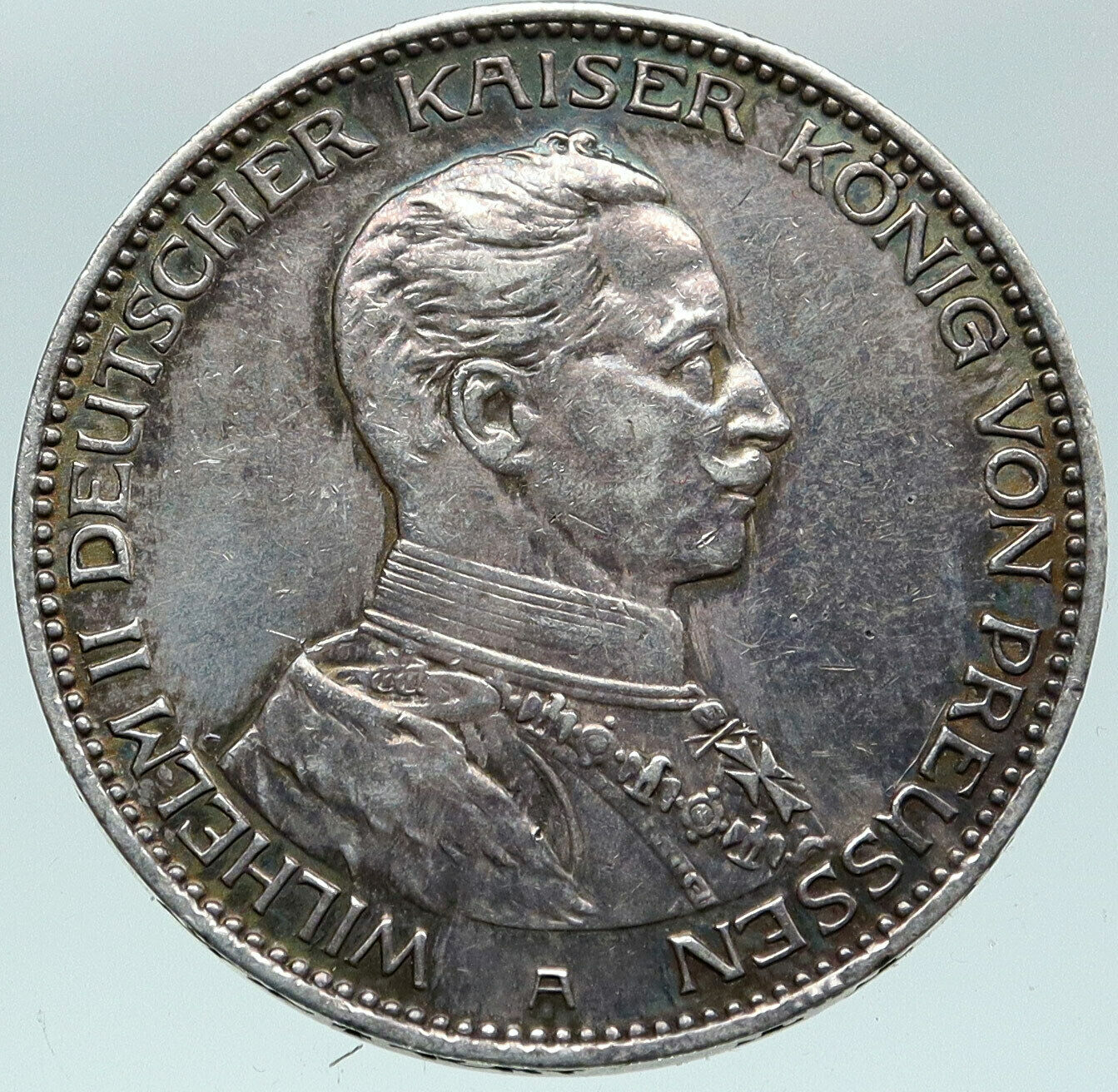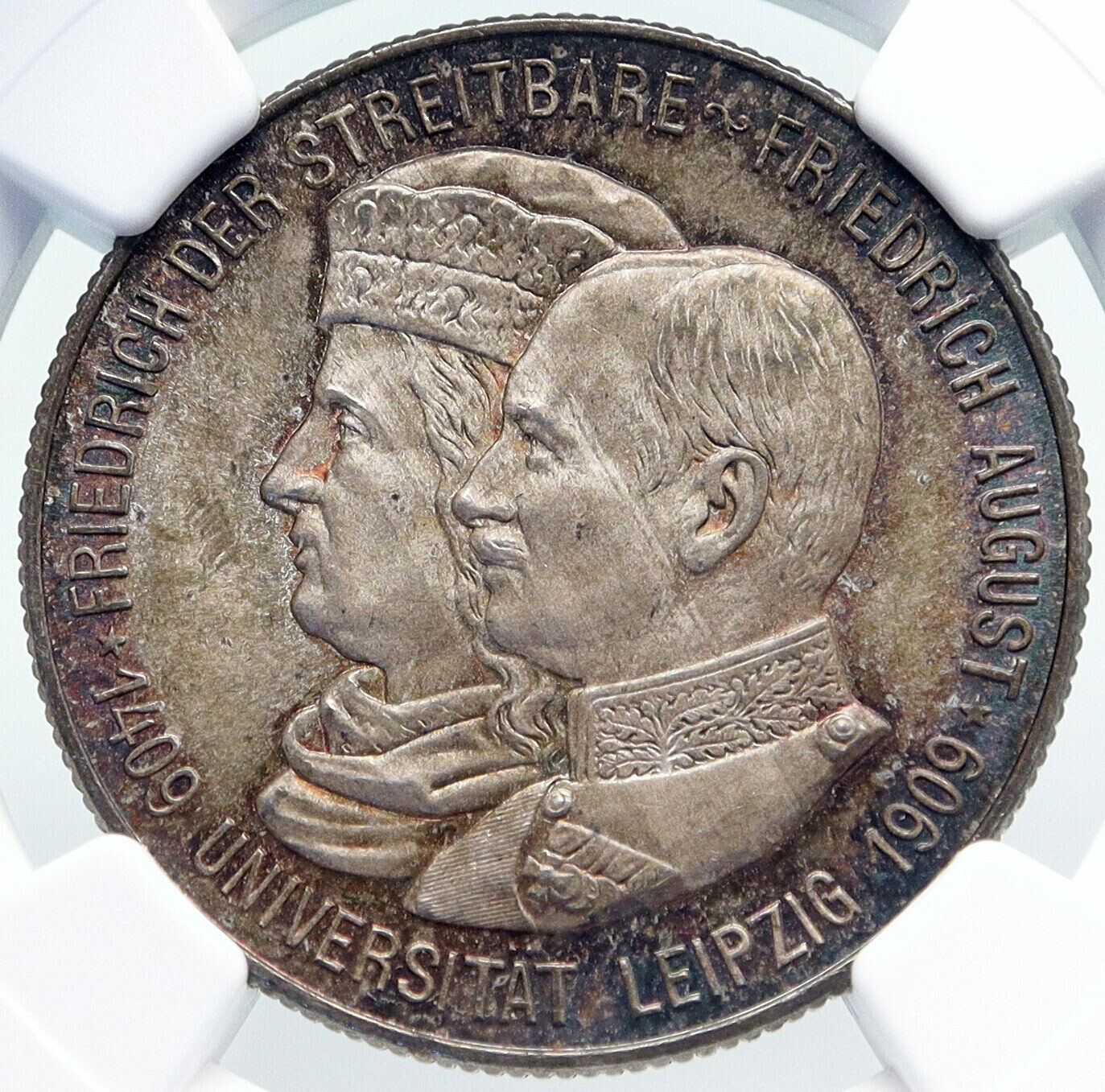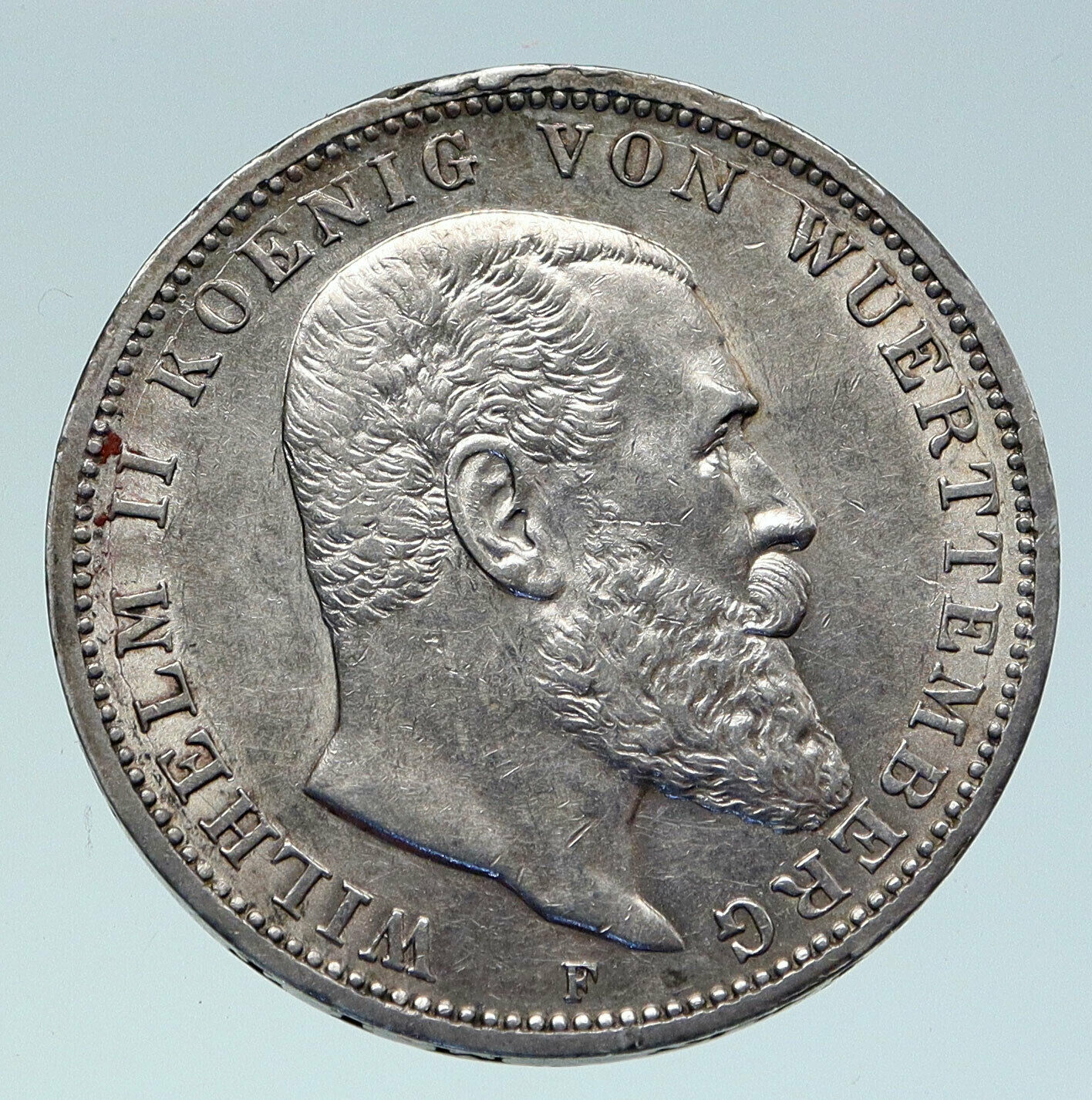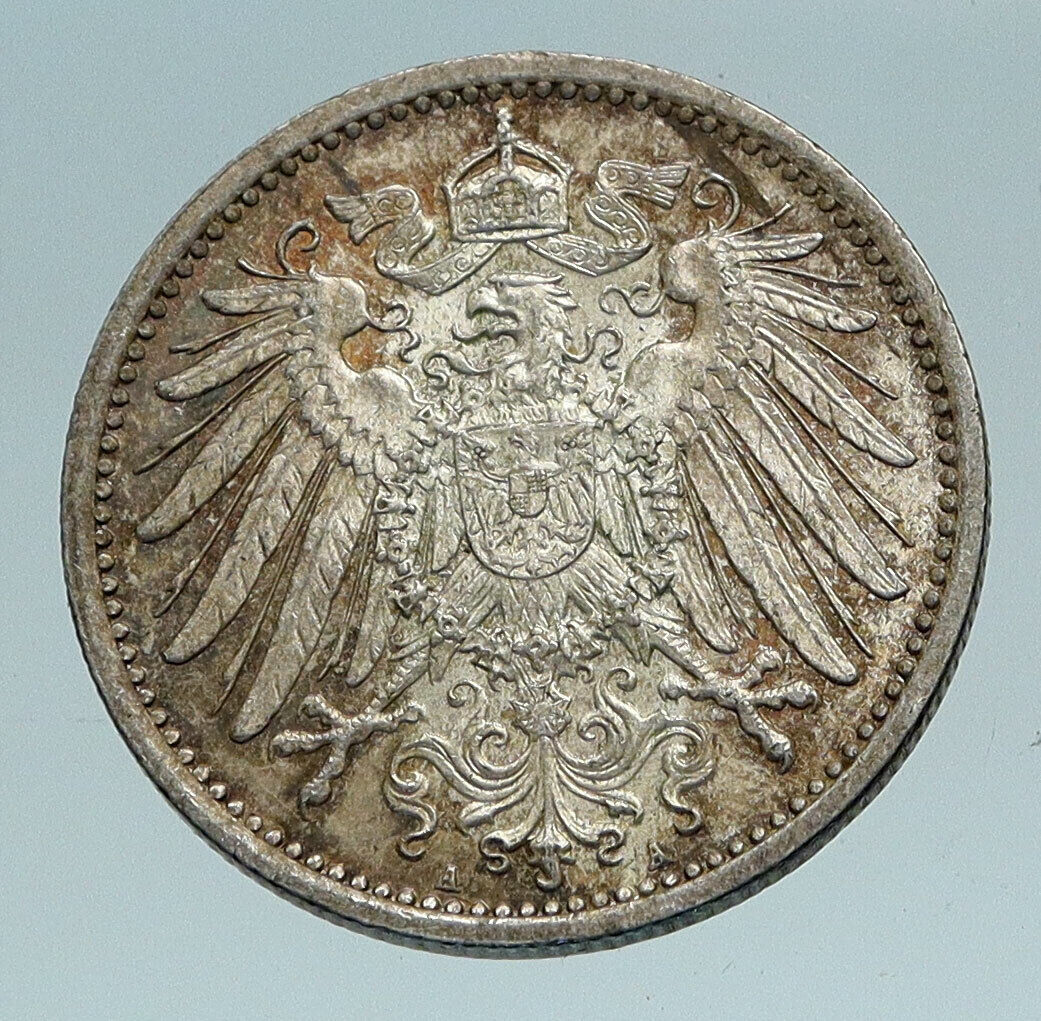|
Germany – German States – Kingdom of Prussia
Wilhelm II – Emperor: 15 June 1888 – 9 November 1918
200th Anniversary of Prussia
1901 A Silver 2 Mark 28mm (11.12 grams) 0.900 Silver (0.3215 oz. ASW) Berlin mint
Reference: KM# 525
+FRIEDRICH·I·1701· WILHELM·II·1901·, Frederick I and Wilhelm II facing left.
DEUTSCHES REICH 1901 * ZWEI MARK *, Eagle.
You are bidding on the exact item pictured, provided with a Certificate of Authenticity and Lifetime Guarantee of Authenticity.
 Wilhelm II or William II (German: Friedrich Wilhelm Viktor Albrecht von Preußen; Frederick William Victor Albert of Prussia; 27 January 1859 – 4 June 1941) was the last German Emperor (Kaiser) and King of Prussia, ruling the German Empire and the Kingdom of Prussia from 15 June 1888 to 9 November 1918. He was the eldest grandson of the British Queen Victoria and related to many monarchs and princes of Europe. Wilhelm II or William II (German: Friedrich Wilhelm Viktor Albrecht von Preußen; Frederick William Victor Albert of Prussia; 27 January 1859 – 4 June 1941) was the last German Emperor (Kaiser) and King of Prussia, ruling the German Empire and the Kingdom of Prussia from 15 June 1888 to 9 November 1918. He was the eldest grandson of the British Queen Victoria and related to many monarchs and princes of Europe.
Crowned in 1888, he dismissed the Chancellor, Otto von Bismarck, in 1890 and launched Germany on a bellicose “New Course” in foreign affairs that culminated in his support for Austria-Hungary in the crisis of July 1914 that led in a matter of days to the First World War. Bombastic and impetuous, he sometimes made tactless pronouncements on sensitive topics without consulting his ministers, culminating in a disastrous Daily Telegraph interview that cost him most of his power in 1908. His top generals, Paul von Hindenburg and Erich Ludendorff, dictated policy during the First World War with little regard for the civilian government. An ineffective war leader, he lost the support of the army, abdicated in November 1918, and fled to exile in the Netherlands.
.jpg/230px-Frederick_I_of_Prussia_(cropped).jpg) Frederick I (German: Friedrich I.) (11 July 1657 – 25 February 1713), of the Hohenzollern dynasty, was (as Frederick III) Elector of Brandenburg (1688-1713) and Duke of Prussia in personal union (Brandenburg-Prussia). The latter function he upgraded to royalty, becoming the first King in Prussia (1701-1713). From 1707 he was in personal union the sovereign prince of the Principality of Neuchâtel (German: Fürstentum Neuenburg). He was also the paternal grandfather of Frederick the Great. Frederick I (German: Friedrich I.) (11 July 1657 – 25 February 1713), of the Hohenzollern dynasty, was (as Frederick III) Elector of Brandenburg (1688-1713) and Duke of Prussia in personal union (Brandenburg-Prussia). The latter function he upgraded to royalty, becoming the first King in Prussia (1701-1713). From 1707 he was in personal union the sovereign prince of the Principality of Neuchâtel (German: Fürstentum Neuenburg). He was also the paternal grandfather of Frederick the Great.
The Hohenzollern state was then known as Brandenburg-Prussia. The family’s main possessions were the Margraviate of Brandenburg within the Holy Roman Empire and the Duchy of Prussia outside of the Empire, ruled as a personal union. Although he was the Margrave and Prince-elector of Brandenburg and the Duke of Prussia, Frederick desired the more prestigious title of king. However, according to Germanic law at that time, no kingdoms could exist within the Holy Roman Empire, with the exception of the Kingdom of Bohemia.
In the Crown Treaty of 16 November 1700, Frederick persuaded Leopold I, Archduke of Austria and Holy Roman Emperor, to allow Prussia to be elevated to a kingdom. This agreement was ostensibly given in exchange for an alliance against King Louis XIV in the War of the Spanish Succession and the provision of 8,000 Prussian troops to Leopold’s service. Frederick argued that Prussia had never been part of the Holy Roman Empire, and he ruled over it with full sovereignty. Therefore, he said, there was no legal or political barrier to letting him rule it as a kingdom. Frederick was aided in the negotiations by Charles Ancillon.
Frederick crowned himself on 18 January 1701 in Königsberg. Although he did so with the Emperor’s consent, and also with formal acknowledgement from Augustus II the Strong, Elector of Saxony, who held the title of King of Poland, the Polish-Lithuanian Diet (Sejm) raised objections, and viewed the coronation as illegal. In fact, according to the terms of the Treaty of Wehlau and Bromberg, the House of Hohenzollern’s sovereignty over the Duchy of Prussia was not absolute but contingent on the continuation of the male line (in the absence of which the duchy would revert to the Polish crown). Therefore, out of deference to the region’s historic ties to the Polish crown, Frederick made the symbolic concession of calling himself “King in Prussia” instead of “King of Prussia”.
His royalty was, in any case, limited to Prussia and did not reduce the rights of the Emperor in the portions of his domains that were still part of the Holy Roman Empire. In other words, while he was a king in Prussia, he was still only an elector under the suzerainty of the Holy Roman Emperor in Brandenburg. Legally, the Hohenzollern state was still a personal union between Brandenburg and Prussia. However, by the time Frederick crowned himself as king, the emperor’s authority over Brandenburg (and the rest of the empire) was only nominal, and in practice it soon came to be treated as part of the Prussian kingdom rather than as a separate entity. His grandson, Frederick the Great, was the first Prussian king to formally style himself “King of Prussia”.
Frederick was a patron of the arts and learning. The Akademie der Künste in Berlin was founded by Frederick in 1696, as was the Academy of Sciences in 1700, though the latter was closed down by his son as an economic measure; it was reopened in 1740 by his grandson, Frederick II. Frederick also appointed Jacob Paul von Gundling as Professor of History and Law at the Berlin Knights Academy in 1705, and as historian at the Higher Herald’s Office in 1706.[citation needed]
Frederick died in Berlin in 1713 and is entombed in the Berliner Dom.
His grandson, Frederick the Great, referred to Frederick I as “the mercenary king”, due to the fact that he greatly profited from the hiring of his Prussian troops to defend other territories, such as in northern Italy against the French. “All in all,” he wrote of his grandfather, “he was great in small matters, and small in great matters.”
 Germany, officially the Federal Republic of Germany, officially the Federal Republic of  Germany is a federal parliamentary republic in western-central Europe. It includes 16 constituent states and covers an area of 357,021 square kilometres (137,847 sq mi) with a largely temperate seasonal climate. Its capital and largest city is Berlin. With 81 million inhabitants, Germany is the most populous member state in the European Union. After the United States, it is the second most popular migration destination in the world. Germany is a federal parliamentary republic in western-central Europe. It includes 16 constituent states and covers an area of 357,021 square kilometres (137,847 sq mi) with a largely temperate seasonal climate. Its capital and largest city is Berlin. With 81 million inhabitants, Germany is the most populous member state in the European Union. After the United States, it is the second most popular migration destination in the world.
Various Germanic tribes have occupied northern Germany since classical antiquity. A region named Germania was documented before 100 CE. During the Migration Period the Germanic tribes expanded southward. Beginning in the 10th century, German territories formed a central part of the Holy Roman Empire. During the 16th century, northern German regions became the centre of the Protestant Reformation.
The rise of Pan-Germanism inside the German Confederation resulted in the unification of most of the German states in 1871 into the Prussian-dominated German Empire. After World War I and the German Revolution of 1918-1919, the Empire was replaced by the parliamentary Weimar Republic. The establishment of the Third Reich in 1933 led to World War II and the Holocaust. After 1945, Germany split into two states, East Germany and West Germany. In 1990, the country was reunified.
 In the 21st century, Germany is a great power and has the world’s fourth-largest economy by nominal GDP, as well as the fifth-largest by PPP. As a global leader in several industrial and technological sectors, it is both the world’s third-largest exporter and importer of goods. Germany is a developed country with a very high standard of living sustained by a skilled and productive society. It upholds a social security and universal health care system, environmental protection and a tuition free university education. In the 21st century, Germany is a great power and has the world’s fourth-largest economy by nominal GDP, as well as the fifth-largest by PPP. As a global leader in several industrial and technological sectors, it is both the world’s third-largest exporter and importer of goods. Germany is a developed country with a very high standard of living sustained by a skilled and productive society. It upholds a social security and universal health care system, environmental protection and a tuition free university education.
Germany was a founding member of the European Union in 1993. It is part of the Schengen Area, and became a co-founder of the Eurozone in 1999. Germany is a member of the United Nations, NATO, the G8, the G20, and the OECD. The national military expenditure is the 9th highest in the world. Known for its rich cultural history, Germany has been continuously the home of influential artists, philosophers, musicians, sportsmen, entrepreneurs, scientists and inventors.
|





 Wilhelm II or William II (German: Friedrich Wilhelm Viktor Albrecht von Preußen; Frederick William Victor Albert of Prussia; 27 January 1859 – 4 June 1941) was the last German Emperor (Kaiser) and King of Prussia, ruling the German Empire and the Kingdom of Prussia from 15 June 1888 to 9 November 1918. He was the eldest grandson of the British Queen Victoria and related to many monarchs and princes of Europe.
Wilhelm II or William II (German: Friedrich Wilhelm Viktor Albrecht von Preußen; Frederick William Victor Albert of Prussia; 27 January 1859 – 4 June 1941) was the last German Emperor (Kaiser) and King of Prussia, ruling the German Empire and the Kingdom of Prussia from 15 June 1888 to 9 November 1918. He was the eldest grandson of the British Queen Victoria and related to many monarchs and princes of Europe..jpg/230px-Frederick_I_of_Prussia_(cropped).jpg) Frederick I (German: Friedrich I.) (11 July 1657 – 25 February 1713), of the Hohenzollern dynasty, was (as Frederick III) Elector of Brandenburg (1688-1713) and Duke of Prussia in personal union (Brandenburg-Prussia). The latter function he upgraded to royalty, becoming the first King in Prussia (1701-1713). From 1707 he was in personal union the sovereign prince of the Principality of Neuchâtel (German: Fürstentum Neuenburg). He was also the paternal grandfather of Frederick the Great.
Frederick I (German: Friedrich I.) (11 July 1657 – 25 February 1713), of the Hohenzollern dynasty, was (as Frederick III) Elector of Brandenburg (1688-1713) and Duke of Prussia in personal union (Brandenburg-Prussia). The latter function he upgraded to royalty, becoming the first King in Prussia (1701-1713). From 1707 he was in personal union the sovereign prince of the Principality of Neuchâtel (German: Fürstentum Neuenburg). He was also the paternal grandfather of Frederick the Great.  Germany, officially the Federal Republic of
Germany, officially the Federal Republic of  Germany is a federal parliamentary republic in western-central Europe. It includes 16 constituent states and covers an area of 357,021 square kilometres (137,847 sq mi) with a largely temperate seasonal climate. Its capital and largest city is Berlin. With 81 million inhabitants, Germany is the most populous member state in the European Union. After the United States, it is the second most popular migration destination in the world.
Germany is a federal parliamentary republic in western-central Europe. It includes 16 constituent states and covers an area of 357,021 square kilometres (137,847 sq mi) with a largely temperate seasonal climate. Its capital and largest city is Berlin. With 81 million inhabitants, Germany is the most populous member state in the European Union. After the United States, it is the second most popular migration destination in the world. In the 21st century, Germany is a great power and has the world’s fourth-largest economy by nominal GDP, as well as the fifth-largest by PPP. As a global leader in several industrial and technological sectors, it is both the world’s third-largest exporter and importer of goods. Germany is a developed country with a very high standard of living sustained by a skilled and productive society. It upholds a social security and universal health care system, environmental protection and a tuition free university education.
In the 21st century, Germany is a great power and has the world’s fourth-largest economy by nominal GDP, as well as the fifth-largest by PPP. As a global leader in several industrial and technological sectors, it is both the world’s third-largest exporter and importer of goods. Germany is a developed country with a very high standard of living sustained by a skilled and productive society. It upholds a social security and universal health care system, environmental protection and a tuition free university education.




